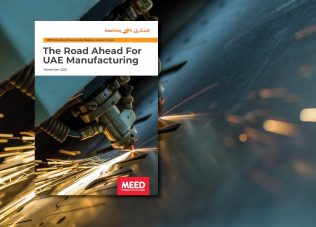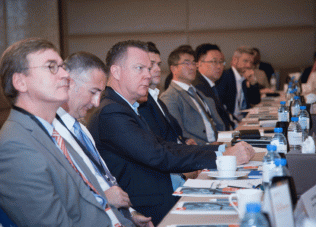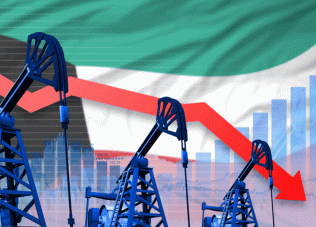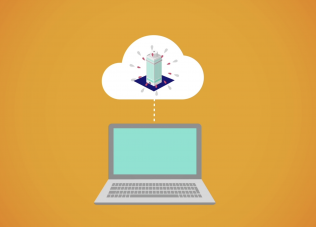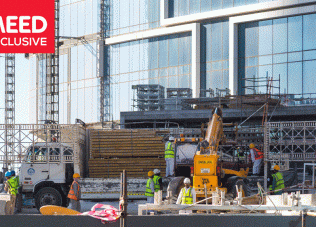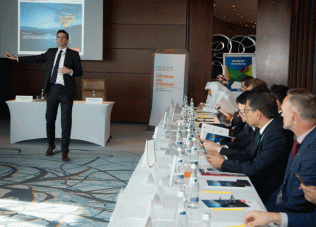Power game: the region’s nuclear energy ambitions

While many of the public announcements emanating from the Middle East and North Africa’s utilities sector over the past couple of years have focused on launching renewable energy programmes, work has been going on behind the scenes on another major energy transformation for the region’s power sector.
Largely due to the sensitivities regarding the deployment of nuclear energy, much of the planning had been taking place in a much less public sphere than the rise of renewable energy. However, this started to change in December when a number of major developments were revealed, starting with the signing of the final agreements for Egypt’s first nuclear project.
The signing of the $21.5bn contract for the El-Dabaa nuclear plant in the North African state on 11 December was followed by news that Saudi Arabia had begun soliciting interest for the first phase of the region’s largest planned atomic energy programme. With the UAE set to commission the first nuclear plant in the Arab world later this year, Jordan, Morocco, Tunisia and Algeria are all considering the option of integrating nuclear power into their energy sectors.
Even Kuwait, which along with Oman and Qatar cancelled previous nuclear plans following the Fukushima nuclear plant accident in 2011, is also believed to be reassessing the potential for deploying the technology in its utilities sector. MEED estimates that up to 37GW of nuclear projects are at various stages of the planning process across the region, which could have a potential value of $165bn.
Diversification drive
The regional push towards nuclear power stems from three perceived benefits: vast generation capacity, diversification of heavily hydrocarbon-based power sectors and carbon-emission free electricity.
At a time when regional and international geo-political tensions are rising, governments are seeking to ensure that they have multiple sources of energy to meet power requirements. Rising electricity demand and lack of progress with developing domestic gas reserves has led to a number of major energy producing countries to begin importing gas to meet domestic demand for power. Robin Mills, CEO of UAE-based energy consultant Qamar Energy, says that a rising gas crunch is a key factor behind the growing race to diversify energy supplies.
“I think the shortage of gas is a big part of it. Egypt has been importing gas the last few years and Saudi Arabia is thinking about it,” explains Mills. “Egypt has more gas coming online soon [from the Zohr field], but this will allow for a few years for demand growth and then they may be short again.”
In addition to concerns over long-term gas supplies, the region’s oil-producing countries are increasingly seeking to maximise the benefits of their hydrocarbon resources on the export market.
“The region’s energy companies are looking at the high opportunity cost of building power plants running on oil or gas, and that’s obviously fairly significant for Saudi Arabia,” says Bob Bryniak, CEO of energy consultancy firm Golden Sands, and previous CEO of Oman Power & Water Procurement Company (OPWP).
Capacity creation
The sheer-scale of power produced from nuclear plants is also a key reason for developing the technology across the region, with many of the region’s utilities struggling to cope with rapid population growth and industrial diversification.
“Nuclear power can provide significant capacity additions, and come online in chunks of 5 or 7GW,” says Bryniak. “I think that is why the UAE developed nuclear first, before other new resources such as coal, and in Saudi Arabia peak demand is expected to more than double in the next couple of decades, so nuclear can go a long way towards meeting that.”
Bryniak is keen to stress that the expected sustained mid-long term growth for electricity in the region is a key driver behind the development of nuclear power, with construction of atomic generation facilities taking an average of 8 years to complete.
Reliable power supply
The unprecedented rise of renewable projects across the Middle East and North Africa over the past five years, driven largely by the dramatic fall in costs, has led to many in the utilities sector to question the decision to pursue expensive nuclear power when the region contains some of the most fertile conditions for solar energy in the world.
The cost of photovoltaic (PV) solar panels fell by 80 per cent between 2007 and 2015, and this has resulted in the region setting numerous world records for low unsubsidised solar tariff prices. The most recent example was the award of a contract for Saudi Arabia’s first major renewable project for a tariff price of only $c2.34 per kilowatt hour ($c/kWh), on par or even lower than thermal power and nuclear generation facilities.
However, the potential for nuclear power to provide a sizeable and reliable baseload supply of supply has convinced some utilities that it is worth pursuing, in spite of the significant capital costs.
“The big issue with renewables, which has been the case for a number of years, is that a megawatt of solar is not equal to a MW of nuclear and gas – and that is because it is due to reliability,” says Bryniak. “If it’s not sunny or windy, then you aren’t getting the full megawatt, and storage capability has not been developed to the point where it can be entirely made up with storage. That means, if you are going with renewables then you need to have more megawatts from a conventional source because of higher reliability.”
Public support
Public perception of developing nuclear power in Middle Eastern states is generally less negative than some countries in Europe and Asia, including Germany which decided to phase out nuclear power generation by 2022 following the Fukushima disaster in 2011. This has been exemplified in the UAE, where a public survey conducted in 2013 found 82 per cent were in favour of the country developing the technology.
Bryniak credits the UAE’s success in harnessing public support and a strict regulatory body as a driver for other countries planning to follow the nuclear option.
“The UAE has done well in leading the way in terms of nuclear power, especially with regards to the regulatory aspect,” Bryniak explains. “They have taken their time and haven’t rushed it, with a methodical approach, which has partly led to the current delays. I think Saudi Arabia sees this and is keen to take the same route.”
Cost concerns
Although the region’s utilities do not seemingly face a public backlash over developing nuclear power, the vast capital cost of developing the technology will provide a major challenge.
With the UAE and Egyptian projects both costing upwards of $20bn, securing financing will provide a stern test for even hydro-carbon rich states. The lower-oil price environment and a drive to tighten fiscal deficits will require substantial support from nuclear providers and banks.
“Financing will be the key issue,” says Bryniak. “Saudi Arabia is looking to develop up to 18 nuclear projects in groups of 4-6GW, which will require a significant amount of project financing.”
Despite the UAE and Egypt’s first nuclear projects both expected to have similar capacities and construction costs, both have been financed in very different ways.
For the $24.4bn UAE project, the Abu Dhabi government is providing a $16.2bn direct loan, 66 per cent of the total financing, with the Export-Import Bank of Korea (Kexim) providing a $2.5bn loan in addition to equity commitments of $4.7bn from Enec and the group developing the plant, Korea Electric Power Corporation (Kepco). The project also received a loan from a number of banks, including the local National Bank of Abu Dhabi.
For Egypt’s first foray into nuclear power, the Russian Finance Ministry is supporting its state nuclear company with 85 per cent of the financing in the form of a government-to-government loan for the estimated $21.5bn project. Cairo will only be responsible for the remaining 15 per cent of required financing.
According to Bryniak, the Arab World’s first two nuclear projects will provide a useful blueprint for other governments to secure financing for capital intensive nuclear schemes.
“I think the UAE will crack the ice on the project financing side, and that will help Saudi Arabia establish its programme moving ahead. There will also be the opportunity for the growing Islamic finance market to be used to financing a nuclear sector. Saudi Arabia is also planning to mine uranium from up to 7 or 8 sites to assist with nuclear fuel production, which would help considerably with running costs.”
Despite the challenge posed by raising such vast financing, Bryniak does not see it as insurmountable.
“It is something that lenders will have to get comfortable with, but if the regulatory environment is strong I don’t think it will be a stumbling block. I think it will come through.”
With support for developing nuclear energy seemingly gathering pace across the region, successful implementation of the ambitious plans will likely be dependent on the ability of individual governments to garner political and financial support from the international community.
With increasing political schisms and tensions across the region, governments pursuing nuclear power will need to placate international concerns and ensure adequate safety and regulatory provisions are put in place to attract interest from power providers.
The financial challenges of nuclear power implementation will likely prove the sternest test. While, when fully commissioned, nuclear power plants can generate electricity for a relatively low cost, the cost of building the plants is vast. On top of this, the main challenge facing regional rulers and governments is establishing competitive and diversified economies in the lower-oil price era. With governments keen to ensure that capital-intensive nuclear power projects do not impede economic development, securing financing from international lenders and foreign governments will be critical if the region’s nuclear plans are to become reality.
